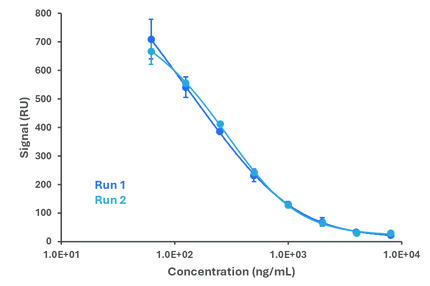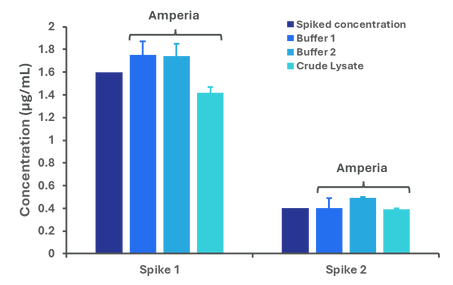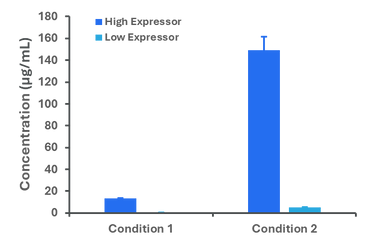Sponsored Content by AbselionReviewed by Olivia FrostNov 27 2025
Every year, the VIB Nanobody Core screens and classifies hundreds of constructions, making it an international leader in nanobody (VHH) discovery and engineering. Spectrophotometry technologies, such as Nanodrop, are routinely used for fast measurements, although they can produce inaccurate results in crude lysates.
On the other end of the spectrum, VIB's core facility offers high-quality biophysical analysis utilizing techniques such as SPR; nevertheless, these are not intended for quick, routine concentration checks. Amperia™ was tested for its ability to quickly and consistently quantify His-tagged nanobody expression in crude materials.
Experimental design
The VIB Nanobody Core tested the Amperia platform for fast measurement of His-tagged nanobodies in purified and crude lysate forms.
- Samples: His-tagged nanobody standards and E. coli lysates.
- Assay: Amperia His-tag assay run under standard protocol conditions.
- Matrices: Buffer and crude lysate to test matrix compatibility.
- Measurements: Calibration, spiked recovery, and quantification of crude samples.
- Objective: Test reproducibility, accuracy, and consistency across sample types.
Key outcomes
- Reproducible performance: Amperia demonstrated reproducible His-tag nanobody quantification across repeated runs, indicating measurement stability.
- Accurate Recovery: Spiked samples in buffer and crude lysate recovered within predicted ranges, indicating accuracy and matrix tolerance.
- Direct quantification: Direct measurement of His-tagged nanobodies in crude E. Coli lysates without purification, allowing for quicker screening.
- Robust results: Calibration, recovery, and sample data demonstrate reliable performance for routine nanobody analysis.
Amperia allowed us to directly measure his-tagged nanobody concentrations from crude samples with reproducible results across days. This gives us faster, more consistent insight into our expression systems”.
MSc. Ema Romão, VIB NANOBODY® VHH CORE
Data highlights
Calibration curve consistency
The Amperia His-tag test yielded a stable concentration-response relationship for the nanobody standard, with repeatable findings across runs.

Figure 1. Calibration data for His-tag nanobody quantification confirming reproducible assay performance. Image Credit: Abselion
Recovery accuracy
Spike recovery studies showed appropriate quantification in both buffers and crude lysate, supporting Amperia assay reliability across many matrices.

Figure 2. Recoveries were within the expected range across all matrices, confirming Amperia assay accuracy and matrix tolerance. Image Credit: Abselion
Quantification of crude samples
Amperia was used to evaluate crude E. coli lysates from two different expression settings. The assay clearly differentiated between high- and low-expression samples, displaying sensitivity across several experimental formats.

Figure 3. Quantification of His-tagged nanobody samples from two expression conditions. Amperia differentiated high and low expressors in crude lysates. Image Credit: Abselion
Dilution consistency
To determine matrix tolerance, crude lysate dilutions from Condition 1 were examined using Amperia™. Concentration values were consistent across the dilution series, showing accurate measurement even for low-expression samples.

Figure 4. Quantification of diluted crude lysate samples from Condition 1 on Amperia, showing consistent concentration results across dilutions. Image Credit: Abselion
Conclusion
- Amperia™ enables quick, quantitative assessment of His-tagged nanobodies in crude lysates.
- The results were consistent across buffers and lysate matrices, indicating accuracy and reproducibility.
- Dilution and recovery experiments showed consistent results across various sample concentrations.
- The data demonstrates Amperia's suitability for accurate His-tag protein quantification in nanobody screening procedures.
About Abselion
Abselion started in 2018, at that time under the name HexagonFab, in a small corner of a laboratory at the University of Cambridge.
We set out with the humble goal to make protein research simpler. Scientists should be able to pursue their passion for discovery and innovation, rather than spend their valuable time with tedious, manual tasks. With RED we had access to the ideal technology to create this product. A product that is so compact that it could fit on every bench, and so affordable that it is accessible to everyone. Over the years we have designed, built and tested our first product Amperia and we’re proud to introduce it to the world.
Sponsored Content Policy: News-Medical.net publishes articles and related content that may be derived from sources where we have existing commercial relationships, provided such content adds value to the core editorial ethos of News-Medical.Net which is to educate and inform site visitors interested in medical research, science, medical devices and treatments.